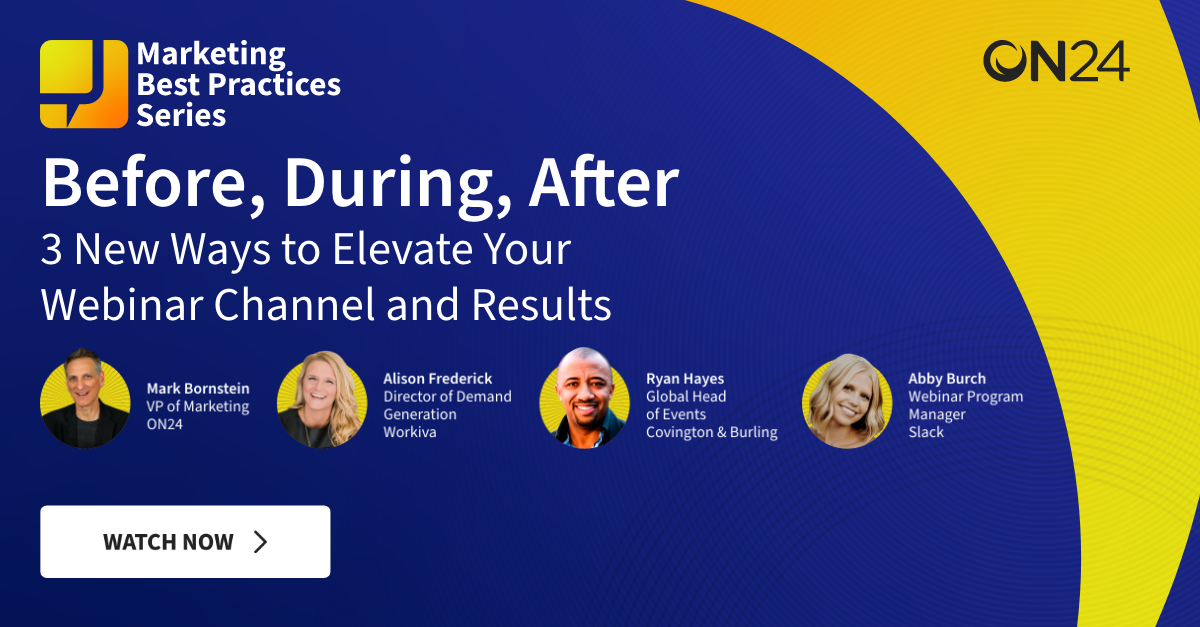Getting a webinar program up and running isn’t easy. You have to build webinar consoles, draft content, rehearse presentations and, most important of all, get the audience you want to engage with to attend your virtual event.
But what, exactly, should a B2B marketer do before their webinar goes live? To find out, we sat down with three experts — Allison Frederick, Director of Demand Gen at Workiva; Ryan Haynes, Global Head of Events at Covington Burling; and Abby Dilger, Webinar Program Manager at Slack — to find out what they do before, during and after their webinars to drive engagement.
Here’s what they had to say.
Have a strategic plan in place

First, our panel of experts recommends taking a big-picture view of what you want to accomplish with your webinar program. Marketers need to evolve their webinar thinking from one-off tactical actions to a strategic centerpiece of their content marketing strategy and pipeline generation.
“It really starts with curating that event list and tearing our webinar program, positioning our webinars against our best bets in terms of pipeline progression,” Frederick said.
As a result, Frederick said Workiva’s webinar program quickly became one of the company’s most important revenue-driving channels.
For Covington Burling, Haynes said the law firm’s webinar program is focused primarily on a diverse set of thought leadership content. While planning out various topics to produce is important, Ryan notes that his firm is shifting away from short-term actions and thinking more about how they can turn the events they produce into long-lasting on-demand experiences.
“We can actually stop and focus on what how to leverage that event longer term better, how to extend the life of this one content generation piece,” Ryan said. “It [the event] has longer legs so it can reach more people in a more direct way.”
Key to planning a long-term content strategy is analyzing the data generated from events. Ryan and his team not only review who attended which webinar but also keep a sharp eye on how long an attendee engages with an event and how the combination of those two factors links to the firm’s business strategy.
For Dilger, the planning process is largely the same: understanding who is attending Slack’s webinars, why they’re attending and figuring out what digital events Dilger’s team can produce to align target audiences with Slack’s business strategy.
Dilger said that the key to this alignment was working with subject matter experts to craft a webinar roadmap.
“Basically what happens is there’s dates on there and times available and people for their target audience pick out a date,” Dilger said. “And we kind of work backwards from there. And we found that that helps us a lot in our strategy and our planning because before it was like, hey, we want to do this webinar.”
Tactics for webinar promotion

Planning your webinar program is all well and good, but actually getting audiences to attend your event is a different matter.
Thankfully, our panel of experts has a few tactics that work well in getting audiences in the door.
Focus on attendee quality over quantity
Match promotions to the scale of your event — Virtual events — from webinars to virtual conferences — scale in intensity. For example, Tier 1 events, which need to bring in hundreds or thousands of attendees, will necessarily need a different promotional strategy than Tier 3 events, like a webinar series.
Make sure you budget — both money and energy — accordingly. Make sure your big-tent events have the promotional juice they need, from organic to paid, to meet your goals. Not every digital event you create is going to be a blockbuster. And that’s fine. In fact, Haynes even said that, really, he doesn’t pay attention to the number of attendees — what matters is matching your webinar to audience interests.
Experiment with promotional channels
Take advantage of every channel — There’s more to webinar promotion than just emails (though promotional emails for webinars are important!). Our panel of experts suggests marketers experiment with different channels and tactics.
For example, Dilger uses Instagram to drive program awareness by having guests and hosts record a 30-second video promoting the event. Similarly, Haynes and his team use LinkedIn to add a personal touch and directly promote events to potential registrants.
Don’t forget paid — Depending on your event’s goals, paid approaches may be a viable promotion option. And don’t be afraid of being creative and going beyond paid ads! Dilger said that her team would develop creative webinar swag packs, like a “webinar watch kit” that includes flavored popcorn — to encourage registrations and attendance.
Personalize and scale outreach
Focus on personalization — Each panelist said personalization is one of the most important aspects of webinar promotion. And personalization efforts can extend beyond email. Haynes suggests marketers try integrating personalization elements into social media posts.
Integrate AI into your process — Every member of our panel is working on integrating artificial intelligence into their webinar marketing program, especially when drafting promotional content.
For Frederick, Dilger and Haynes, that simply means using AI in marketing to quickly create first drafts of emails and abstracts that they can refine to meet their needs.


